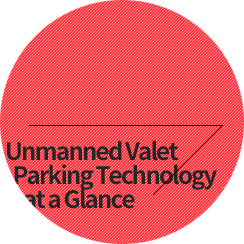
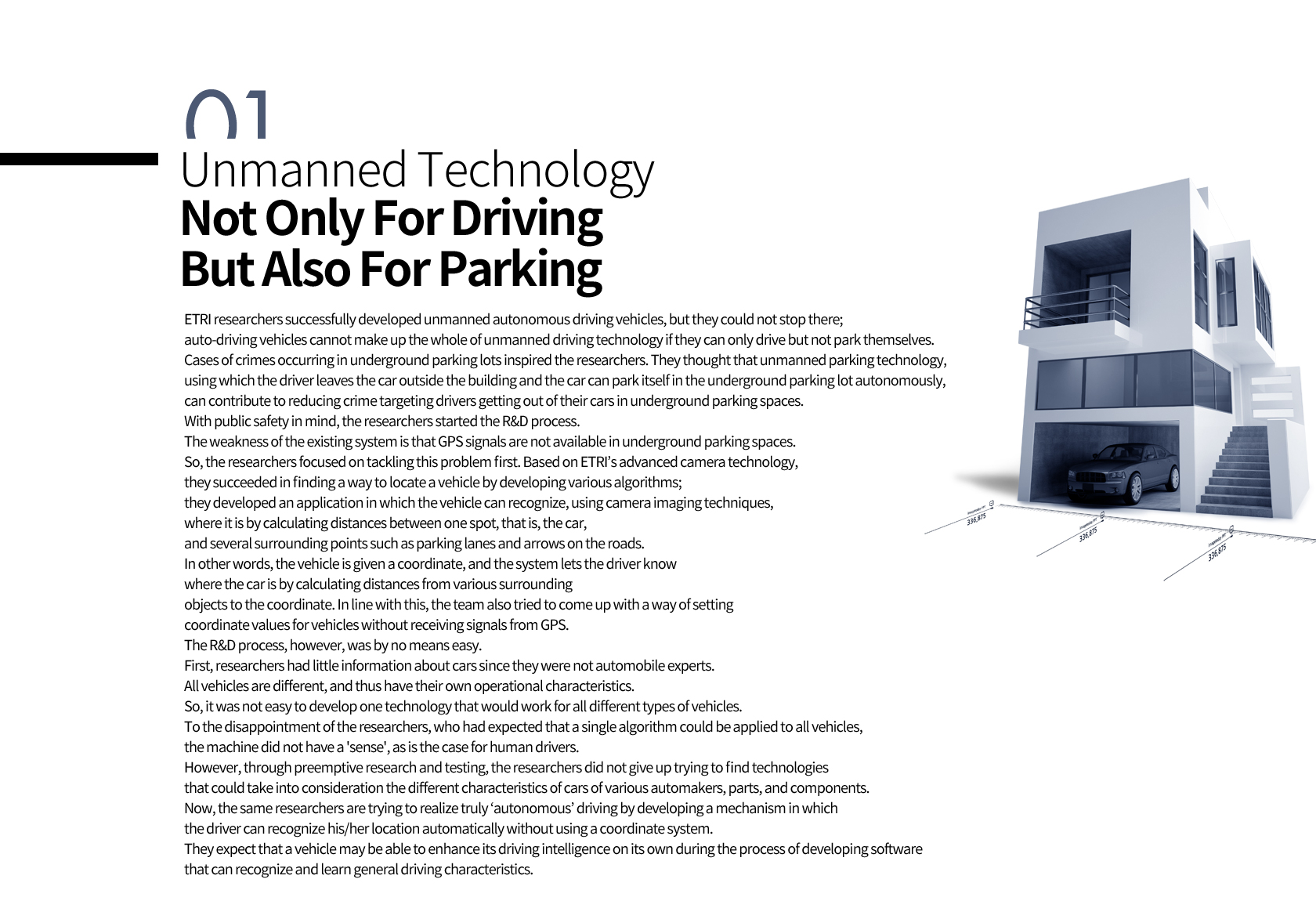
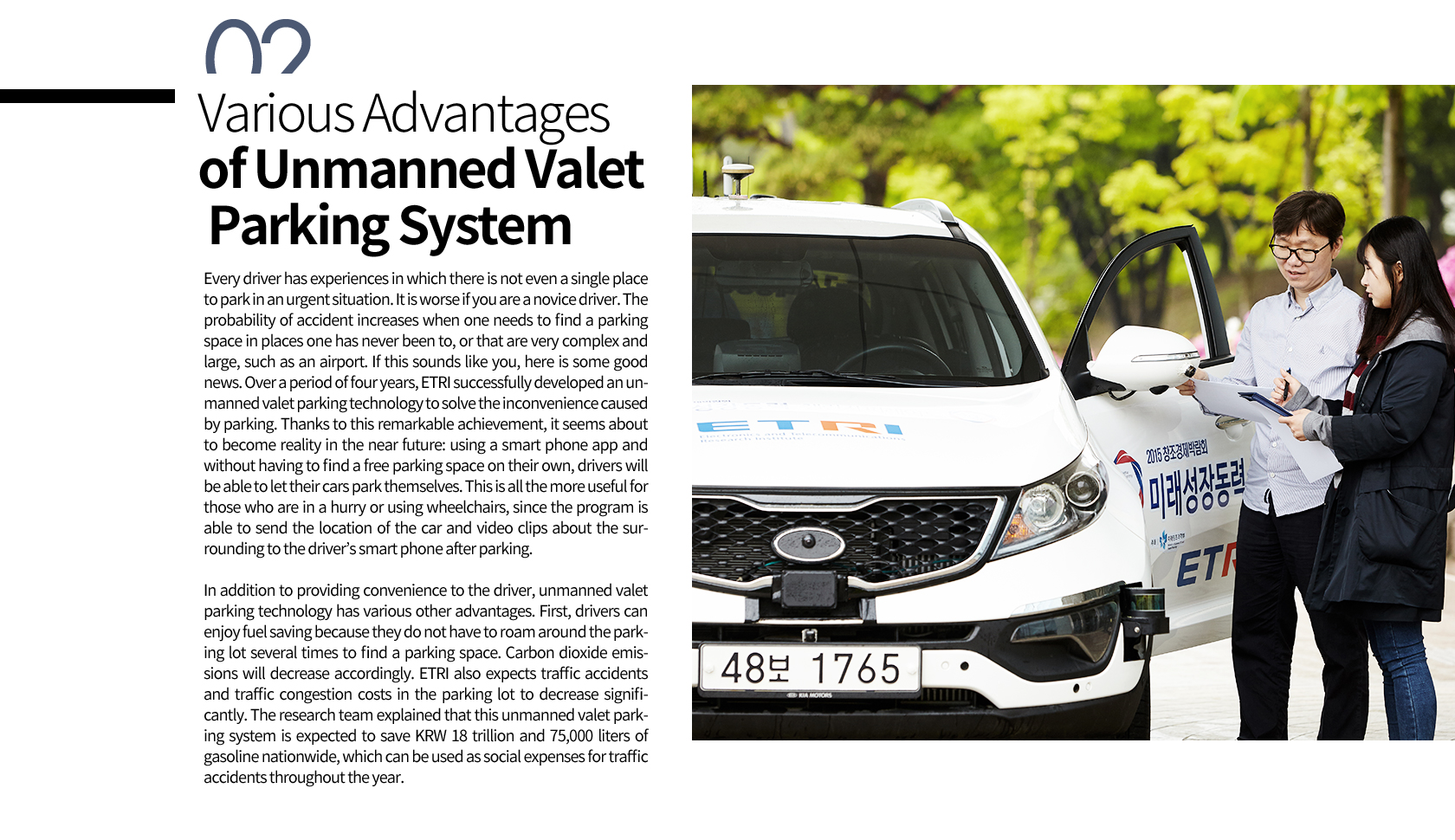
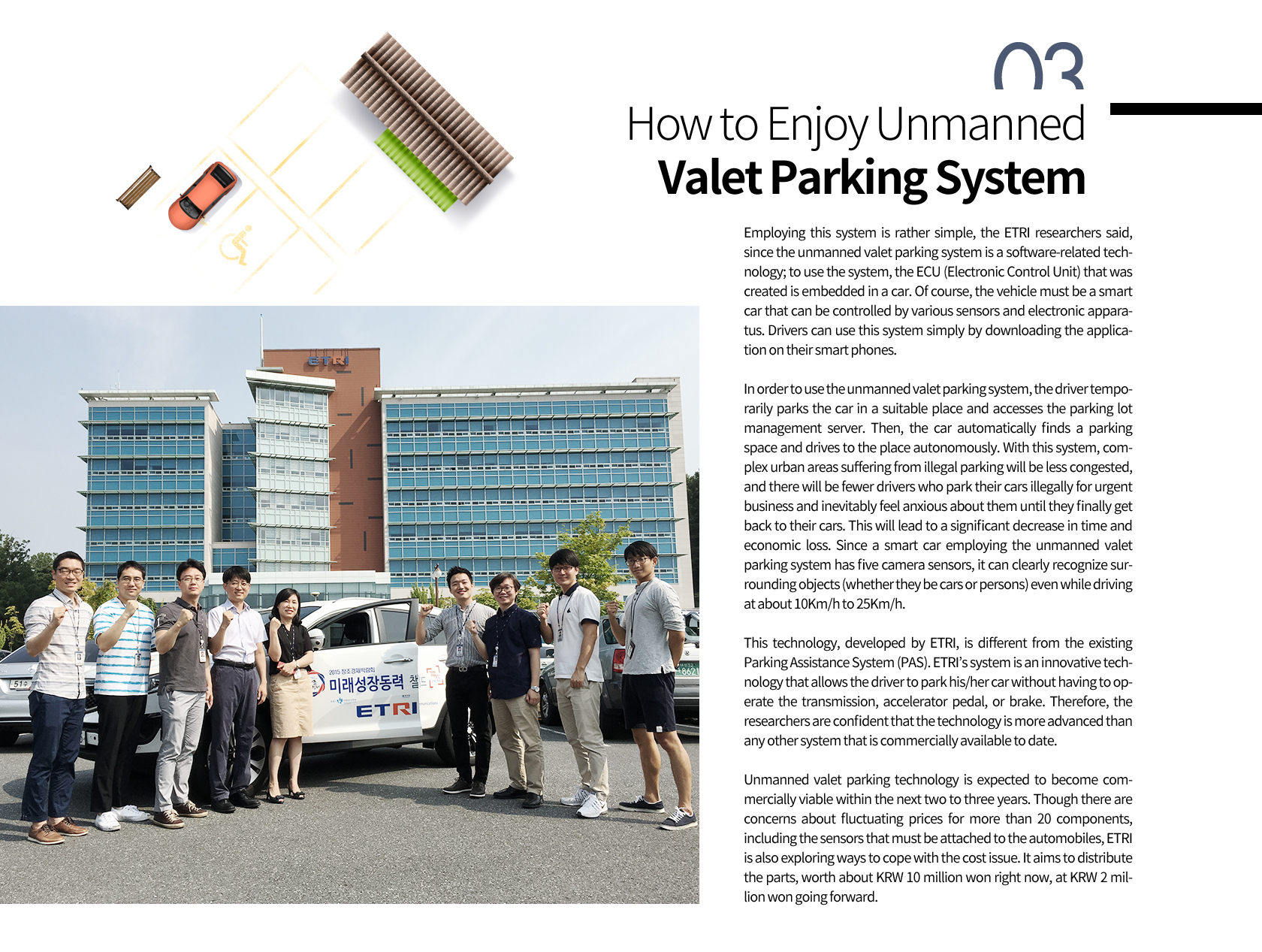

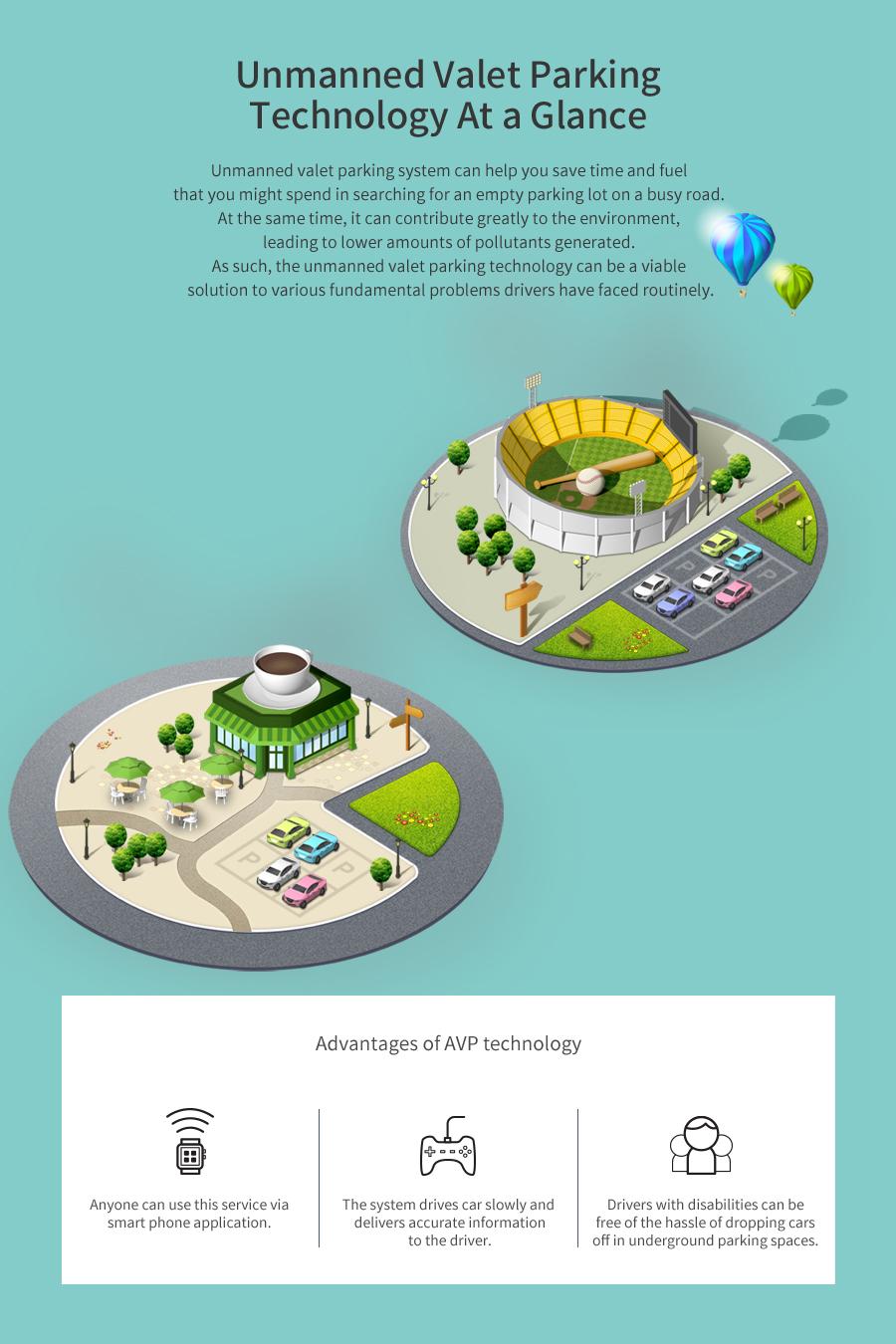

Unmanned
Technology for Human
Autonomous valet parking (AVP) system is a technology that allows a driver to park his/her vehicle without manually operating it; the system involves mounting five camera sensors and 10+ ultrasonic sensors on a vehicle and installing space recognition sensors in the parking lot. It is a key source technology for the ‘transportation vulnerable’, made possible by IT convergence of intelligent automobiles and road infrastructure. This remarkable technology is expected to create high value-added services in the transportation sector. The core of this technology, as described by ETRI, is a driving and parking path generation and tracking system, an infrastructure map-based space recognition system, and a terminal system for parking information. Some of the relevant technologies have been incorporated into ISO, thanks to efforts of the team of researchers at ETRI.
01
Unmanned Technology
Not Only For Driving
But Also For Parking
ETRI researchers successfully developed unmanned autonomous driving vehicles, but they could not stop there; auto-driving vehicles cannot make up the whole of unmanned driving technology if they can only drive but not park themselves. Cases of crimes occurring in underground parking lots inspired the researchers. They thought that unmanned parking technology, using which the driver leaves the car outside the building and the car can park itself in the underground parking lot autonomously, can contribute to reducing crime targeting drivers getting out of their cars in underground parking spaces.
With public safety in mind, the researchers started the R&D process. The weakness of the existing system is that GPS signals are not available in underground parking spaces. So, the researchers focused on tackling this problem first. Based on ETRI’s advanced camera technology, they succeeded in finding a way to locate a vehicle by developing various algorithms; they developed an application in which the vehicle can recognize, using camera imaging techniques, where it is by calculating distances between one spot, that is, the car, and several surrounding points such as parking lanes and arrows on the roads. In other words, the vehicle is given a coordinate, and the system lets the driver know where the car is by calculating distances from various surrounding objects to the coordinate. In line with this, the team also tried to come up with a way of setting coordinate values for vehicles without receiving signals from GPS.
The R&D process, however, was by no means easy. First, researchers had little information about cars since they were not automobile experts. All vehicles are different, and thus have their own operational characteristics. So, it was not easy to develop one technology that would work for all different types of vehicles. To the disappointment of the researchers, who had expected that a single algorithm could be applied to all vehicles, the machine did not have a 'sense', as is the case for human drivers. However, through preemptive research and testing, the researchers did not give up trying to find technologies that could take into consideration the different characteristics of cars of various automakers, parts, and components. Now, the same researchers are trying to realize truly ‘autonomous’ driving by developing a mechanism in which the driver can recognize his/her location automatically without using a coordinate system. They expect that a vehicle may be able to enhance its driving intelligence on its own during the process of developing software that can recognize and learn general driving characteristics.

02
Various Advantages
of Unmanned Valet
Parking System
Every driver has experiences in which there is not even a single place to park in an urgent situation. It is worse if you are a novice driver. The probability of accident increases when one needs to find a parking space in places one has never been to, or that are very complex and large, such as an airport. If this sounds like you, here is some good news. Over a period of four years, ETRI successfully developed an unmanned valet parking technology to solve the inconvenience caused by parking. Thanks to this remarkable achievement, it seems about to become reality in the near future: using a smart phone app and without having to find a free parking space on their own, drivers will be able to let their cars park themselves. This is all the more useful for those who are in a hurry or using wheelchairs, since the program is able to send the location of the car and video clips about the surrounding to the driver’s smart phone after parking.
In addition to providing convenience to the driver, unmanned valet parking technology has various other advantages. First, drivers can enjoy fuel saving because they do not have to roam around the parking lot several times to find a parking space. Carbon dioxide emissions will decrease accordingly. ETRI also expects traffic accidents and traffic congestion costs in the parking lot to decrease significantly. The research team explained that this unmanned valet parking system is expected to save KRW 18 trillion and 75,000 liters of gasoline nationwide, which can be used as social expenses for traffic accidents throughout the year.

03
How to Enjoy Unmanned
Valet Parking System
Employing this system is rather simple, the ETRI researchers said, since the unmanned valet parking system is a software-related technology; to use the system, the ECU (Electronic Control Unit) that was created is embedded in a car. Of course, the vehicle must be a smart car that can be controlled by various sensors and electronic apparatus. Drivers can use this system simply by downloading the application on their smart phones.
In order to use the unmanned valet parking system, the driver temporarily parks the car in a suitable place and accesses the parking lot management server. Then, the car automatically finds a parking space and drives to the place autonomously. With this system, complex urban areas suffering from illegal parking will be less congested, and there will be fewer drivers who park their cars illegally for urgent business and inevitably feel anxious about them until they finally get back to their cars. This will lead to a significant decrease in time and economic loss. Since a smart car employing the unmanned valet parking system has five camera sensors, it can clearly recognize surrounding objects (whether they be cars or persons) even while driving at about 10Km/h to 25Km/h.
This technology, developed by ETRI, is different from the existing Parking Assistance System (PAS). ETRI’s system is an innovative technology that allows the driver to park his/her car without having to operate the transmission, accelerator pedal, or brake. Therefore, the researchers are confident that the technology is more advanced than any other system that is commercially available to date.
Unmanned valet parking technology is expected to become commercially viable within the next two to three years. Though there are concerns about fluctuating prices for more than 20 components, including the sensors that must be attached to the automobiles, ETRI is also exploring ways to cope with the cost issue. It aims to distribute the parts, worth about KRW 10 million won right now, at KRW 2 million won going forward.








